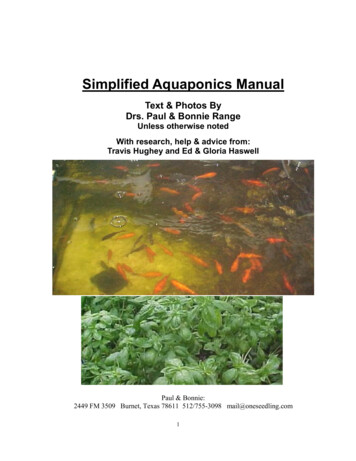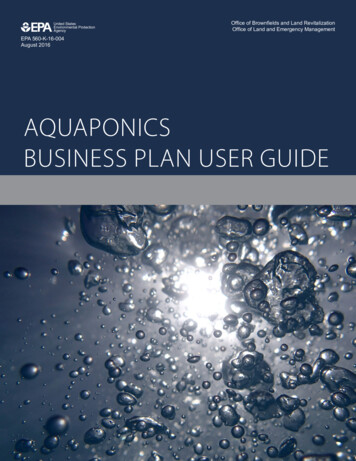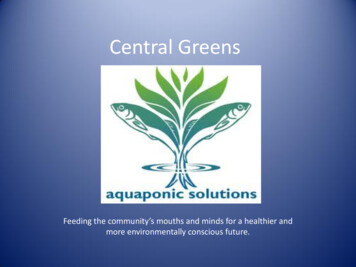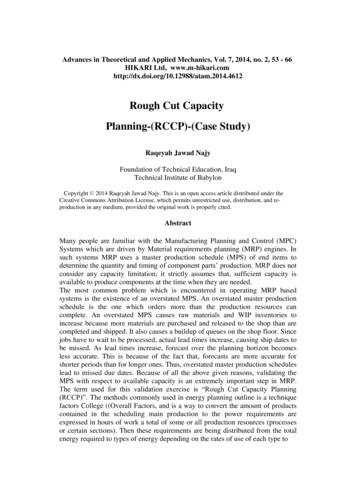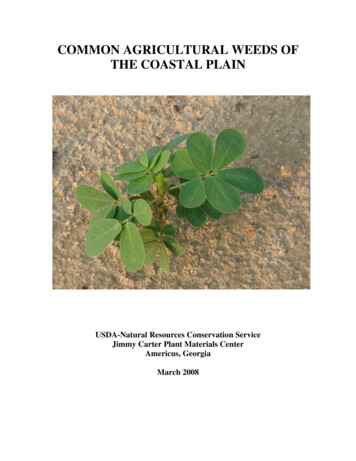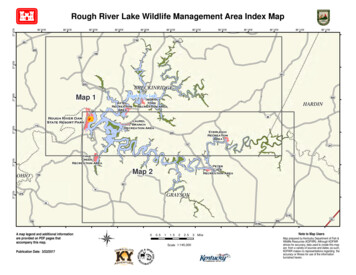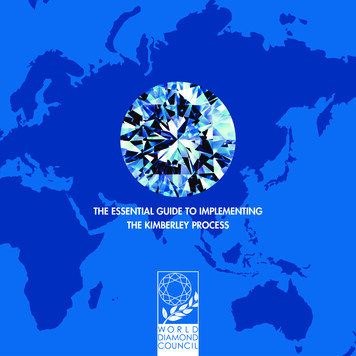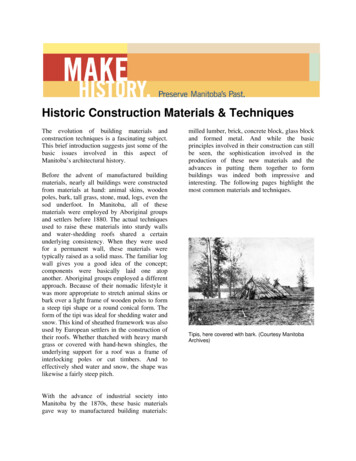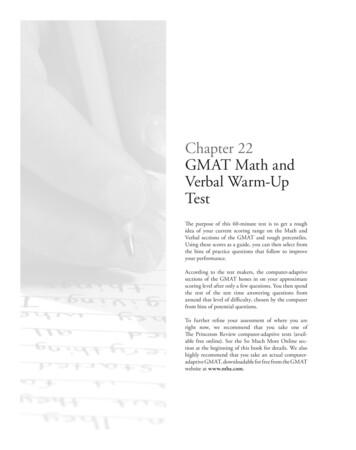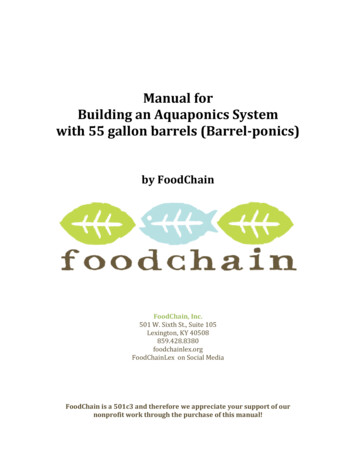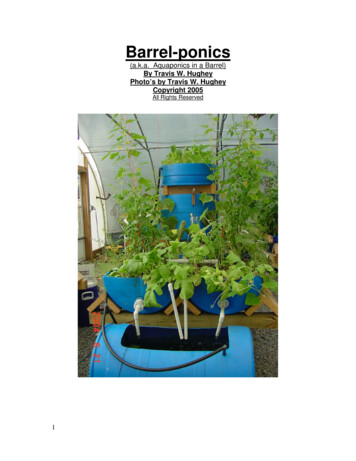
Transcription
Barrel-ponics(a.k.a. Aquaponics in a Barrel)By Travis W. HugheyPhoto’s by Travis W. HugheyCopyright 2005All Rights Reserved1
Conditions of Use StatementThis document, in part or in its entirety, may be copied, reproduced or adapted tomeet local needswithout permission from the author or publishers, provided credit is given toTravis W. Hughey.These provisions apply only provided the parts reproduced are distributed free orat cost – not for profit.Travis W. Hughey would appreciate being sent a copy of any materials in whichtext or illustrations have been adapted.For reproduction on commercial basis, permission must be firstobtained from Travis W. Hughey.Any commercial or for sale application of the Flood Valve technology is strictlyforbidden without prior approval in writing from Travis W. Hughey.Travis W. Hughey can be reached at aquaponic70@yahoo.com .2
Table of ContentsCover Page . 1.Conditions of Use Statement . 2.Table of Contents . 3.Introduction . 4.How It All Began . 5.Let the Danger Begin! . 6.Jumpin’ In . 7.“I Don’t Have the Education!” . 7.The Nitrogen Cycle . 7.What the Plants Need . 8.What the Fish Need . 9.Parts List for Aquaponics System .10.Swimin’ with the Fishes . 13.Barrel Growbed Construction . 22.Building the Stand . 28.Building the Floodvalve . 43.Assemble the Sub-assemblies . 49.Let’s Put This Thing Together . 61.The Floating Raft Tank . 69.Movin’ the Water . 75.Plumbing It All Together . . 76.Options . 80.Maintenance . 87.Starting the System . 89.Why I do What I Do . 91.A Little Bit Of What To Look Forward To . 92.3
IntroductionIf you are looking for an introduction to aquaponics that is simple to build, funto watch and demonstrate to friends and family the joy of soil less gardening.This small unit may be for you. It is capable of growing various vegetables andherbs and would be a wonderful addition to the home kitchen as a source offresh herbs and occasionally (depending on the species used) a fish or two.What it most likely won't do is provide the vegetables to sustain someone on it'sown. That is for a much larger system. Fish production is also limited because ofthe small size of the unit. The actual production possible is mainly dependant onthe operators ability to manage it. I have personally grown tilapia in this systemto about 1/2 Lb. Not a lot of them, just a few. I have grown tomato plants andpapaya trees in this system with nothing more than 4 each of 1/2Lb. tilapia asthe nutrient source. Remember this is not magic. This systems fish tank at thelowest point in the cycle will only have a little over 20gal. of water in it. In myopinion it's simply not practical in the real world to grow high densities of fish andhave a system that is forgiving at the same time. This unit is specificallydesigned as an introduction to aquaponics and to make one familiar with theprincipals involved with minimal expense. It is very adaptable to situations whereconventional electric pumps may not be practical. This is all about learning funand not intended to be a commercial unit in itself although I believe the principlescan be enlarged to do so. Please read this material in it's completion beforeattempting to build this unit. If you are unfamiliar with something don't worryabout it too much. It will come clear as the project progresses. Before we getinto the system please allow me to give a little information about myself.4
How it all BeganI first became interested in aquaponics after acquiring a greenhouse in thespring of 2002 from a local middle school here in coastal South Carolina. Theschool system here was converting to a "Technical curriculum" and no longerneeded the mainstay piece of equipment of their horticulture class. A donationto the PTA and a few weekends of hard work by my family and the green housewas on our property. Now what to do with it? It was a 28 x 45 hoop stylegreenhouse with cooler, fans, and all the standard equipment.I then started researching what to do. The first thing I considered washydroponics but decided it wasn't for me after visiting a hydroponic tomatooperation and found out there was a hazardous waste byproduct that had to behauled off periodically. I'm not saying hydroponics is a bad thing at all. I'm justsaying it wasn't for me at the time. I wanted to do something unique and duringa web search ran across the term "aquaponics". This intrigued me as I was abiology major at Oral Roberts University but never got to finish my educationthere. This was a natural fit, aquaculture and horticulture in a soiless medium.The search led me to Tom and Paula Spraneo. They were selling a manual onaquaponics so I ordered it. To say it opened my eyes was an understatement tosay the least. Their manual is very informative and I highly recommend it if it isstill available. Tom and Paula have done a great service to have helped in thepioneering of this great technology. I must say I was a little intimidated at firstbut became more and more comfortable with the information the more I studiedit. Our quest then led us to an opportunity to attend an aquaculture workshop in2003 that included aquaponics as one of the topics. The workshop was hostedby Charlie Johnson of Aquaculture International in Bryson City, NC. It was avery informative time with a lot of contacts I still have today. There were a lot ofmission minded types there and they as well as I saw the importance of thistechnology in feeding the poor.There was one person there that really grabbed my attention. His name isFrank NcNeely and he is the owner of Aqua-Terra Gardens in Springfield, MO.He was doing aquaponics in old recycled fiberglass bathtubs salvaged from ahotel renovation. That inspired me and got me to thinking. I had been puttingtogether a mold to make my growbeds out of fiberglass. Why not use anabundance of plastic barrels I had laying around. By the time my wife (Lori) andI returned home I had the basic idea on how to use these barrels as growbeds. Icouldn't wait, but had to, as my job did not afford much time to pursue mynewfound passion. I definitely had enough information to be dangerous now.5
Let the Danger Begin!!Beginning in September of 2003 I started putting together a S&S basedsystem in concept but using low cost materials. That's the beauty of aquaponics,you are only limited by your imagination. The system was started in earlyOctober of 2003 and I made all the mistakes everyone talks about. Mostmistakes are made early on from mere impatience. Trying to push the systemtoo hard in the beginning is a sure formula for disaster. It is no fun carrying outbuckets full of dead fish and frantically trying to find out why they are dying.Every person new to aquaculture has the potential to be a serial fish killer. I wasno exception. Once the system stabilizes though it is amazingly resilient. Myexperience with this system has taught me many things and I look forwardlearning much more in the future.After working with this system it became apparent to me that this technologywould be a Godsend to areas of the world where there is no soil or it is verypoor. Many cultures in the world suffer from malnutrition and I believeaquaponics may be one of the solutions to the problem. One of the problems isthat aquaponics is somewhat technical and may not be appropriate in it's currentform. This is what got me to thinking about a small system that could be built inorphanages and teach the principals of aquaponics in such a way it could beeasily understood and become commonplace. For this to happen the technologyhas to be reliable and in-expensive. I started working on the idea for a smallbarrel based system. This system had to be simple, visual and reliable. I startedworking on a variation of a system that Frank NcNeely used as a training tool. Itinvolved using a toilet float attached directly to the flapper of a standard flushvalve. The problem I found was under very low flow situations the flapper wouldlift just enough to allow the water to flow but wouldn't dump the tank as needed.It was about 9:00 in the evening in March of 2004 and I was coming up against awall. Frustrated and feet soaking wet from playing with water for hours I juststopped and prayed. I knew the Creator of the universe had the answer to theproblem as simple as this, I just needed to clear my frustration and listen to Him.By 11:00 that night I had the initial prototype working on even the slightest trickle.A few refinements to the initial concept and the first system was put togetherusing the barrel half growbeds. That system is still in operation today. Workingday and night with the slightest maintenance required. The flood valve is fullyadjustable as to flood volume and cycle time parameters and uses no timers orfloat switches for it to operate. It is very inexpensive to build and is just plain funto watch operate. It is very visual and definitely captures the attention of passersby. Well, let's get started with the system.6
Jumpin' In"I Don't Have the Education !"First let me explain that you do not have to have a college degree to besuccessful with aquaponics on the home level. Just like you do not have tounderstand the chemical process that goes on during combustion in the engineof your car to successfully operate it you do not need to fully understand thecomplexities of the biochemistry involved in aquaponics. You do need to know afew things though just as you do to operate your car. If you get the chance toattend an aquaponics course or seminar I highly recommend it. If not there isalways the school of hard knocks. Just be sure you start small. That's what thismanual is all about. The first basic of aquaponic is the nitrogen cycle. It is howtoxic ammonia fish waste is ultimately converted to not as toxic nitrates. Thefollowing is information provided from Nelson/Pade Multimedia. ThanksRebecca!!The Nitrogen CycleReprinted with permission from Nelson/Pade Multimedia, publishers of theAquaponics Journal, www.aquaponics.comMore than 50% of the waste produced by fish is in the form of ammonia,secreted through the gills and in the urine. The remainder of the waste isexcreted as fecal matter, undergoes a process called mineralization whichoccurs when Heterotrophic bacteria consumes fish waste, decaying plant matterand uneaten food, converting all three to ammonia and other compounds. Insufficient quantities ammonia is toxic to plant and fish. Nitrifying bacteria, whichnaturally live in the soil, water and air convert ammonia first to nitrite(Nitrosomonas bacteria) and then to nitrate (Nitrobacter) which the plantsconsume. Nitrifying bacteria will thrive in the gravel beds and in the water in thesystem. The plants readily take up the nitrites and nitrates in the water and, inconsuming it, help to keep the water clean and safe for the fish.7
What the Plants NeedPlants need nutrients in the proper amounts, oxygen, CO2, water and light.They can come from natural or artificial means. Aquaponics takes advantage ofa natural process in a controlled environment and fulfills these requirements.Plant roots need oxygen which brings us to the need for a flood and drainrequirement for the growbeds. If plant roots would tolerate continual emersion inwater we would not need to drain the grow beds and could simply flow waterthrough continuously. There are several different schemes to accomplish thisusing timers, float switches or even computer control. The flood valve eliminatesthe need for such technology. I'm not saying technology is bad. I use it whenavailable. It is a good thing. It's just not available everywhere.I have grown a large variety of vegetables in my system and the only one's Ihave had trouble with are squash. They seem to be very sensitive to themoisture level of the system and almost always have powdery mildew problems.A partial list of successfully grown vegetables, fruits and herbs in my systeminclude tomatoes, onions, peppers (sweet and hot from bell to habanero), beans,beets, brocolli, basil, cilantro, papaya, collards, cucumbers, carrots, lettuce,stevia, moringa, dill, chard, okra, peas and parsley to name a few. The plantsthrive in this environment and the planting densities are much higher than in aconventional garden.8
What the Fish NeedFish need clean oxygen rich water and reliable feed to thrive. The water alsoneeds to be at the right temperature. Conditions that are tolerable vary fromspecies to species. One would have to get information elsewhere concerningthe specific species desired. All you need is an aquatic animal with gills toprovide the basic nutrients for the nitrogen cycle to operate and the bacteria tomake the conversion for the plants to take up the nutrients. It is a naturalprocess that simply has to have the right conditions to occur.The bacteria and plants in my system keep the water crystal clear and thewater has the sweet smell of healthy creek water. This is one of the basicindicators I use to check the overall health of the system. If it get's out ofbalance you will know it. When things die they smell bad. Whether it's fish ormicrobes. The most common cause of problems in a stabilized system is overfeeding. The water gets cloudy and the first reaction is to get nervous about thechange. I just back off the feed for a day or two. The fish will be fine unlessthere is a toxin causing the problem. At which point they will probably be lostanyway. The key to all this is to familiarize oneself with the day to day operationand nuances. It will become intuitive after a while. Have fun with this and don'tworry too much.As far as feed goes it all depends on the fish you are using. I have tilapia in mysystem. Tilapia are a wonderful choice in tropical climates as they are extremelyforgiving as far as water quality is concerned and they are not picky eaters. Theyare vegetarians and will consume leafy scraps from the garden as well as waterhyacinth, water lettuce and duckweed. I have even had them gobble up driedrabbit pellets just as if it were fish feed. They do very well on standard floatingfish feed and I have even heard of people feeding them dog food when the fishpellets are not available. Don't forget about the natural feeds available in yourarea. There are large amounts of protein flying about in the form of insects andwould be attracted by a light suspended over the fish tank at night. Not tomention worms, grubs, maggots, etc.9
Parts List For Aquaponics SystemFirst let me state that this list is for parts commonly found in the UnitedStates. Please don't be put off by the detail of the list. If these things arecommon to your area or village fine, if not, be creative, this is a guide to how Ihave done it in the states. By all means please don't be discouraged. I ampresently working on ways to accomplish the same thing with different materialsthat would be appropriate in different parts of the world. I will make that infoavailable as the development and testing is done. I don't want to steer youwrong!! Now here are the parts you needPVC parts:a. 1 ft. 1/4" pex pipeb. 3 each of 1-3/4" long 1/2" pipec. 1 each 3" long 1/2" piped. 4 each 4" long 1/2" pipee. 1 each 6" long 1/2" pipef. 2 each 10" long 1/2" pipeg. 2 each 12" long 1/2" pipeh. 1 each 3" long 3/4" pipei. 1 each 4" long 3/4" pipej. 1 each 6" long sch 40 1" pipek. 1 each 19" long 1" thin wall pipel. 2 each 8 1/2" long 1" thin wall pipem. 8 each 1/2" ell (Lowes #26054, 10 pk.)n. 6 each 1/2" male adapter (Lowes # 23855)o. 2 each 3/4" male adapter (Lowes # 23856)p. 1 flush valve (Lowes # 24452)q. 1 each 2" female adapter (Lowes # 23906)r. 1 each 2"x1" sch 40 bushing (Lowes # 22909)s. 1 each 1 " street ell (Lowes # 1636)t. 1 each 1" tee (Lowes # 23876)u. 2 each 1"x3/4" ell (Lowes # 42980)v. 1 each 1/2" IPT to 1/2" 90deg. barb (Lowes # 54092)w.2 each 1/2" IPT to 1/2" barb (Lowes # 53802)x. 1 each 3/4" threaded ball valve (Lowes # 21482)y. 1 each 3/4" street ell PXM (Lowes # 22699)z. 34” of 4" corrugated slittted sewer pipe (The type used in septic systems.Not the type with holes).aa. AR 1/2" black poly pipe (type used in irrigation)bb. 3" of 3/8" vinyl tubingMisc. fittings needed to couple pump to unit dependent on pump used.10
Hardware is as follows:cc. 6 each 1/2"conduit locknuts (Lowes # 75443)dd. 2 each 3/4" conduit locknuts (Lowes # 75450)ee. 1 each 3/8"x 1/2" FIP coupler with insert (Lowes #27258)ff. 1 pkg. screen door tension rollers (Lowes # 46757)gg. 1 each 24" steel fishing leader (Walmart fishing section)hh. 2 each #10 SS pan head sheet metal screwsii. 2 each #8 SS pan head sheet metal screwsjj. 1 each #10 SS flat washerkk. 1 each 1/4" split shot (preferably brass)ll. AR 3/8" SS flat washersmm. 1 each 1 liter water bottle ("Clear American" brand flavored water fromWalmart)nn. 1 small tube of aquarium siliconeoo. 1" by 2 1/2" by 4" long wood blockpp. 1" by 1" by 7" long woodqq. AR 1/2" foam sheet (blue type used for insulation)rr. AR 2" net pots (available from Aquatic Eco-systems)ss. 2 each 1-5/8”deck screwsFramework materials for 55 gal. system are as follows:4 each 10' 2x4's3 each 8' 2x4's1 each 12' 2x6's1 each 12' 2x8's8 each 8" cinder blocksAR 3" deck screwsPump specs:Pump for system should be capable of a bare minimum of 100 gal./hr @ 5ft.headGravelGrowbeds will require 12 each 50lb. bags of pea gravel (600 lbs.) for the 55gal. system.11
BarrelsThree barrels will be required for each system and should be barrels used forfood products only. Do not use barrels from questionable sources that havehad unknown substances for the growing of food. It could be hazardous toyour health. Generally speaking, white or blue plastic barrels will be safe to useonce cleaned. I would avoid using black barrels as they are used primarily forchemical storage. Always make sure what you are using. Never recycle barrelsthat have no labels on them indicating what they were used for. There are somenasty surprises inside some of these. Always err on the cautious side.I prefer to use blue barrels as they don’t grow algae as much as white ones butwill be using white ones for this manual as it is easier to see the layout lines.Tools needed:Safety glassesJigsaw with new blade.1/2" drill1/2" NPT tap (optional but nice if you have it)3/4" NPT tap (optional but nice if you have it)1/8" drill bit5/32" drill bit1/4" drill bit3/4" spade bit1" spade bit2-1/2" hole sawdriver bit for deck screwstape measuresharpie pen and pencilframing square12" channel locks6" adjustable wrench12
Swimmin' with the FishesLet's get started with the simplest part of the system to build, the fish tank.No, this is not where the saying "easy as shooting fish in a barrel" came from.We aren't going to shoot the fish here!! Besides, it would put holes in the wrongplaces. Gather the following parts from the parts list:1-Plastic Barrel1-3/4" PVC male adapter1-3" long piece of 3/4" PVC pipe1-3/4" PVC threaded ball valve1-3/4" PVCstreet ell1-3/4" conduit locknutPlease be careful and use safety gear when using power tools. When drillingplastics, tools can at times grab so please be very careful and hold tools firmly.Always be aware of where the blades, drill bits and anything that could causebodily harm are. The purpose of this is to have fun and not spend your qualitytime in the doctor's office. When using a marker to lay out the cuts don't worryabout marks on the barrels. They can be cleaned up with acetone, paint thinner,hairspray, etc. later.13
Take the first clean barrel stand it on it's end with the barrel bungs up. If youlook closely you will see a thin mold line running between the barrel bungs.Find the middle of this line and using a framing square mark a point on theedge of the barrel 90deg. to the mold line on this mark.Flip the barrel over and do the same thing with the other end.14
Now, take a straight edge and make a line on the side from one point to theother the entire length of the barrel. This is the centerline for your cut-out.Measuring in from each end 6" draw a line 90 deg. to the centerline asshown in fig.4 on both sides of the line 6-1/2".15
Now make a line connecting each of these marks.If you want to give the project a little more finished look take a small can orbottle and mark a radius at each of the corners.16
Cut out the center section being careful to secure the barrel while cutting.Clean up the edges of the cut with sandpaper or I use a knife blade and scrapethe edges clean.This is what it looks like with the center section cut out.17
Stand the barrel on it's end with the bottom up.Remember the center mark on the mold line? Using a framing square makea line to the bottom of the tank and mark a point 1-1/2 “ from the edge asshown.18
Drill a 1" hole hereThread in a 3/4” PVC male adapter with silicone on the threads. If you have apipe tap it will make threading the fitting in easier although it is by no meansnecessary.19
I prefer to lock the fitting on the inside with a conduit locknut to make theconnection more secure. The threads sticking through to the inside can be usedto secure a filter if desired.Install the 3” section of 3/4” PVC with the threaded PVC street ell as shown.20
Install the ball valve and whatever fittings needed to hook up the pump youare using and the fish tank assembly is complete It should look something likethis.Give the whole thing a good cleaning inside and out. See how simple this is?Isn’t aquaponics fun?Now lets move on up the system and construct the growbeds.21
Barrel Growbed ConstructionTo build the a growbeds from a plastic barrel you will need the following:1- blue or white barrel (never use black barrels in food producing systems asthese most likely have had toxic chemicals in them)4- 1/2" pvc male adapters.4-1/2” pvc ells.4-1/2” pvc pipe pieces 4” long.2-1/2” pvc pipe pieces 10” long.2-1/2” pvc pipe pieces 12” long.2- 1/2" gray pvc female npt x 1/2" male hose barb.2- 6" to 8" pieces of 1/2" hose to fit over the barb. I use the black pipe used inunderground irrigation systems.1- section of corrugated sewer. The kind used in septic system drain fields withthe slitted sidewalls. The length needed will be the inside length of your barrelplus 1/2”. Do not use the type with holes in it!3” piece of 3/8” I.D. vinyl tubing.Aquarium grade silicone sealer.Let's begin the growbed assembly.Take the barrel to be used for the grow beds and stand it on end with thebottom up. Find the center of the mold line and using a framing square make aline perpendicular to the mold line from the center mark as shown.Be sure to make a mark on each side of the mold line and near the edge.This will be where the grow bed drains will be installed.22
Drill a 3/4" hole on each line 1" from each edge as shown.Now, flip the barrel over so the bungs are facing up and remove the bungs.Using the mold line as a guide take the jigsaw and cut the barrel in halflengthwise on the mold line. Clean the ragged edges with coarse sandpaper orscrape them off with a knife. You should now have two halves as shown.23
If the barrels you are using have a lip around the top it would be a good idea toremove this lip with a jigsaw as it will keep the growbeds from laying flat in theframe.Next take the drain field pipe and look carefully at it and you will notice a moldline on either side of it as well.24
Carefully cut along these lines and set both pieces aside.Now back to the barrel halves. Locate the holes drilled in the first step andfrom the outside thread a 1/2" pvc male adapter into this hole with a little siliconesealer on the threads (if you have a pipe tap this size you can thread the openingto make it easier).25
Install a 1/2" conduit locknut and finish tighten the pvc male adapter.While holding the adapter with some pliers thread the 1/2" female x 1/2" barbto the threads protruding through on the inside. You have just made a bulkheadfitting with a 1/2" female pvc connection on the outside and a 1/2" hose barb onthe inside. It should look like this.26
Slip the short section of hose onto the barb and ensure the curve of the hoseis turned down.One half of the drain field pipe will go over this connection and run lengthwiseon the bottom of the barrel half to create a clear water space for thesiphon to draw water from. The end of the tube should contact the bottom of thegrow bed. I have slightly heated and formed these tubes to get a better fit whennecessary.Thoroughly clean the barrel halves with a good cleaner and then with vinegarto neutralize the soaps. A final cleaning with bleach water is also advised.We will determine the location of the overflow bypass fittings after the stand isbuilt and gravel is in the beds.27
Building the StandOthers have made stands for small barrel based systems with lightermaterials but I would not advise such a thing. The weight of this unit can easilyexceed 800lbs. Please don't skimp on the foundation of such a project.Feel free to use recycled materials of course to save money. Be responsible butby all means be sure it can easily and safely carry the weight.To make the stand you will need the following:6 concrete blocks1 12' 2x61 12' 2x84 10' 2x43 8’ 2x41 lb. 3" deck screwsScrew the 2x6 and the 2x8 together to form a “V” as shown. This is done byscrewing through the 2x8 into the 2x6.28
Cut into 4 sections 35” long as shown.Set these aside.Next screw two (2) 10' 2x4's together to make a 4x4 as shown.29
Cut this into two pieces 54-3/4" long.Next position these pieces on the ground roughly 36" apart and set the two ofthe "V" pieces on top to form a rectangle as shown.30
Put one 3" deck screw in each corner as shown and square the whole thingup by checking diagonals and moving until the diagonals are equal.When they are equal screw the other four corners with 3" deck screws.With these pieces securely screwed in place take another "V" piece and placeit in the middle. Find the exact center and screw it in place as shown.31
Now carefully flip this assembly over.Mark the center of the cross brace as shown and measure out from there oneach side 8".32
Screw 2 more 10' 2x4's together to form a 4x4 and cut into two pieces51-1/2" long to form the longitudinal braces. Keep the excess pieces as they canbe used in another part of the frame.The longitudinal bracing is to be attached as shown. These should be flush onone end and stick out past the barrel cradles on the other.33
Screw these together using 3" deck screws as shown.Carefully flip the assembly back over.Now with the remaining 2x4's cut the following:4 pieces 14" long.4 pieces 23-1/4" long.1 piece 16" long1 piece 19" long.34
Assemble 2 each of the 14" and 23-1/4" pieces as shown with a 3-1/2" offsetat one end and screw together with 3" screws after making sure all is square.You can use the excess pieces saved from making the 51-1/2“ 4x4 pieces here.Use the remaining two 14" and 23-1/4" pieces and assemble another bracketidentical to the one you just did.Attach these to the longitudinals sticking out using 3" deck screws as shown.Note: The brackets are mounted flush on the ends of the longitudinals.35
Now attach the 16" brace to the assembly as shown.Attach the 19" piece as shown.36
You have just finished the growbed frame assembly.It should look like this.37
Now lay out the concrete blocks in a square 26" wide and 50" long making sureto set them perfectly level and square. It is very important that this foundation beset level as the operation of the unit could be compromised if it is not set level.Once the blocks are set lay the frame assembly on as shown.38
Set the barrel halves in the cradles as shownPosition the fish tank and wedge it against the front blocks as shown with theremaining "V" piece.39
With the drain pipe halves in the bottom covering the suction tubes,hold down firmly while someone pours cleaned, washed pea gravel on top tohold the drain pipe halves down.Finish filling the barrels with clean, washed pea gravel being careful to keepthe tops of the barrel halves even and level. Fill to about 1” below the barrelbung holes.Install the 4” long 1/2” pvc pipe pieces, 1/2” ells and 10” long 1/2” pvc pipe intothe male adapters at the bottom of the growbeds pointing up as shown.40
With a garden hose or some buckets fill the growbeds until the water leveljust comes up to the bottom of the barrel bungs and mark the waterline on thefront of the growbeds. Make a mark 1/2” below the water line and drill a 1/2”hole in each growbed at the location shown.Install a 1/2” male pvc adapter into this hole with a 1/2” conduit locknut on theinside on each growbed. Insert a 4” long piece of 1/2” pvc pipe into the maleadapter and install a 1/2”
4 Introduction If you are looking for an introduction to aquaponics that is simple to build, fun to watch and demonstr
